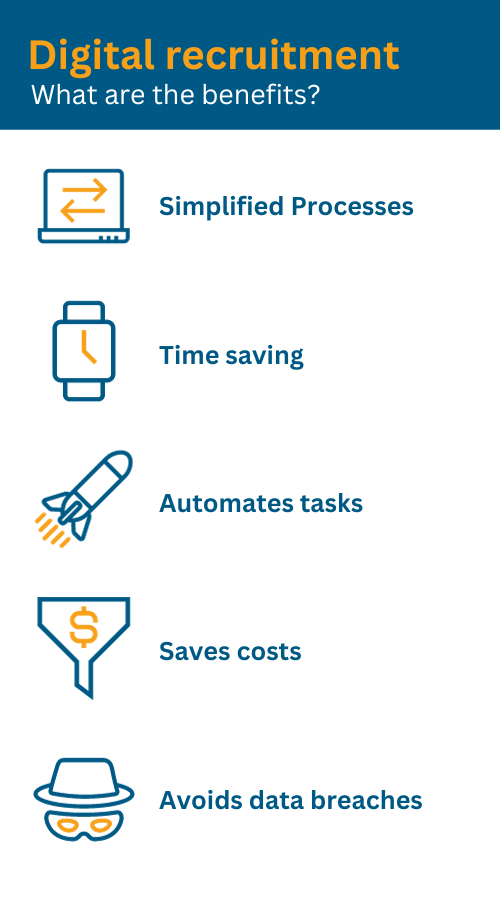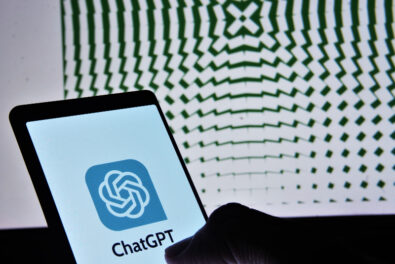
Recruitment is probably the most data-sensitive and time-consuming aspect of HR, so it comes as no surprise that businesses are searching for ways to simply the process and save time and money. Indeed, the direct and indirect costs of hiring a new employee were estimated to be double their average salary in their first year, by Growth Business.
Increasingly companies are reacting to this by, in theory, pairing the human-centric element of HR with powerful digital processes to automate away the busywork, while keeping that friendly, accessible face for new hires. Successful employer branding hinges on these two aspect working well in tandem.
HR has always been an early embracer of technology, not least because it handles the most personal data and touches the lives of employees the most times. According to a survey conducted in 2021, this early-adoption trend only intensified with the pandemic, with HR departments being among the most keen to adopt digital, remote management technology.
What are the biggest problems in recruitment for HR?
The HR department often has a special place in the business as the holder, keeper, and protector of the personal data of hundreds of employees. The information it keeps is equivalent to client information in terms of its importance and confidentiality to the business.
The downside of that responsibility is that recruitment has had a tendency to become, owing to regulatory and legislative requirements in no small part, a labour-intensive process involving a lot of manual inputting and replication of information, which in turn leads to a higher risk of data breaches. Of course part of the overall picture here involves due rigor internally and an effective Information Governance Policy (see our guide here), but even with these in place, the danger of recruitment and employee records getting into the wrong hands still exists.
Written by Pieter Nienaber

Pieter is Office/Compliance Manager at Crown Records Management and has been with our organisation for over 15 years. He started off work in operations and has now worked in most divisions in Records Management and is part of a wonderful team who are passionate about what they do.
How can you solve data problems in recruitment?
Digital HR services have the potential to solve, or help solve, two principle issues within recruitment: data protection and the amount of time wasted on manual tasks.
Just think of the number of manual tasks involved in HR normally: inputting data, sending emails, collecting, and copying information, handling contracts, pensions, payroll, employee benefits. The list is a long one.
What are the benefits of Enterprise Content Management in the recruitment process?
Installing an Enterprise Content Management (ECM) system can have a huge impact. It creates automated workflows which are easy to access and manage.
It can also lead to:
- A significant reduction in the number of hours spent on manual tasks, freeing up employees to take on roles which are more business critical and more fulfilling.
- Increased data compliance
- Simpler processes in every area of recruitment
Saving time is a modern mantra and there are few investments which deliver as big a saving as digitizing recruitment processes.
Research by formstack in 2018 showed that 55% of managers were still spending eight hours a week on manual, repetitive tasks, which is, lets remember, 20% of an entire 40 hour working week. Those labour hours are as any management accountant would know, incredibly valuable (and costly!)
Does digitizing HR functions save money?
There is, of course, an upfront cost to digitizing HR processes (as with any investment in new technology), but embracing digital solutions can save businesses money in the long term.
It will lead to more efficient processes, reducing the risk of data protection fines. There may also be associated cost savings around a reduction in paper and printing and, in some cases, labour costs, too.
It would be wrong to suggest that financial savings should be the primary driver for change, however. In our experience working with HR departments on mapping out this problem, the saving of man hours and, put simply, the making the life of employees simpler is often a bigger focus. After all, we know that if HR professionals aren’t grappling with repetitive manual tasks, that labour can instead be geared towards increasing employee engagement and addressing employee needs.
How does ECM help in the recruitment process?
Take a look at your current recruitment process and consider how many manual and repetitive tasks are involved:
Job description, job adverts and interviews
It might begin with a job description document which is emailed to multiple people and the responses shared internally between managers.
It then goes to the HR department and there may be multiple communications around it. The entire process takes days if not weeks.
The amount of personal data is significant: CVs, references, and email exchanges to begin with. Then contracts to sign, with further personal data required for payroll, tax, pensions, and employee benefits.
What are the benefits of ECM for recruitment?
Once services are digitized you can create a job request via a dynamic job requisition form – no emails – which takes minutes rather than hours to complete.
Automatic job descriptions/specs are created and distributed. You can also browse a database of CVs from a digital system rather than relying on a HR Manager to keep old CVs in a drawer.
As soon as that job request has been requested, it will be distributed to the relevant parties such as a recruitment agent, your own HR team, or your website.
That person then goes through an interview process and the entire process is documented digitally. Notes are made, then references added, then the contracts. All of that is distributed via an electronic platform where workflows happen.
The process continues to be automated during onboarding, which is once again data heavy.
Another important aspect is that ECM makes data easy to find.

It’s easy to locate stats on staff churn and on salary brackets. A dashboard overview allows you to answer questions such as “how much is my organization spending on recruitment agents?”
The HR impact on other departments can improve efficiency, too. IT managers will know immediately when there’s a new hire because an automated notification is sent.
Is now the right time to go digital in HR?
It really is. The amount of data being collected by businesses is rising all the time – and the focus on data protection rises with it.
Millennials and Gen Z also expect the companies they work for to be data savvy, and so it is a recruitment and retention issue, too.
But the most powerful reasons are to make life simpler and to save time.
Most organisations that don’t have a digital approach or a digital archive solution have messy and convoluted process in place – often with no real control over them and little visibility. It’s an important step to take to stay competitive.
If you’d like to get in touch with a Crown Records Management expert about where to begin with digitalizing recruitment processes, then just click here. Remember, Digital transformations don’t need to be overwhelming, they can start with the most basic of processes, like instituting a digital mailroom or scanning and securely storing some important records.








